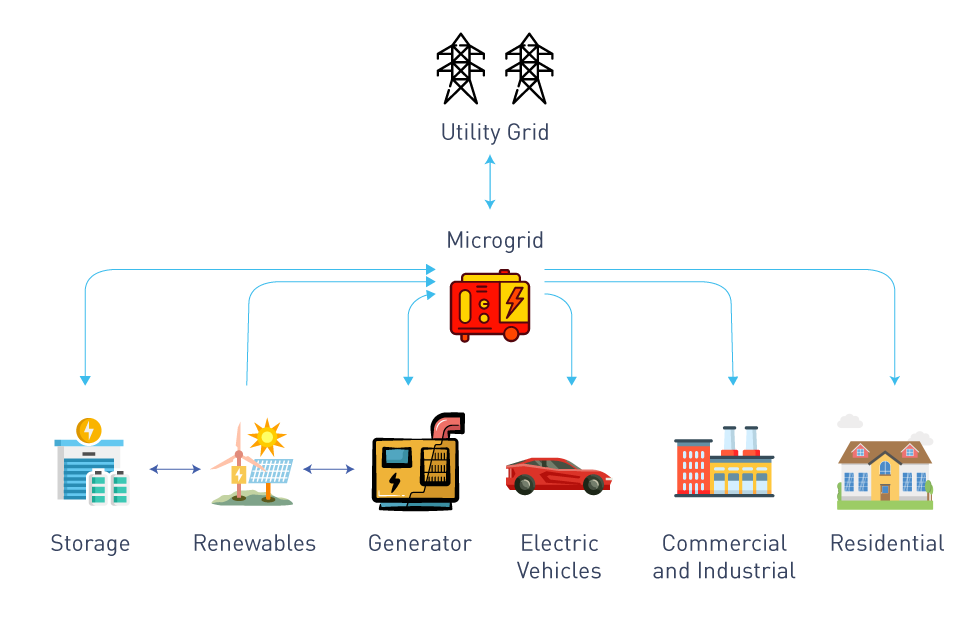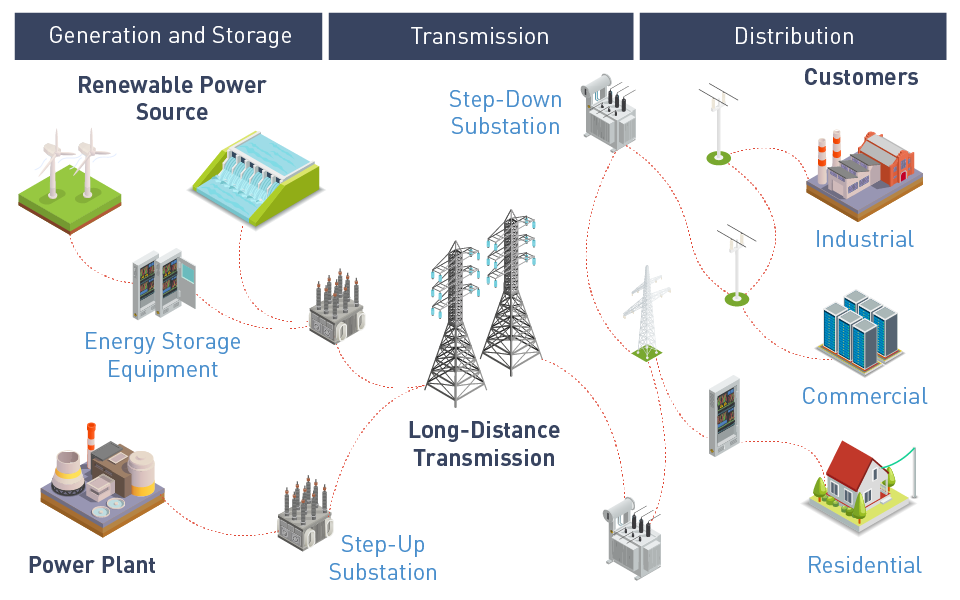National Grids
National grids are the apex of the electrical grid hierarchy, encompassing the complex, large-scale networks that transport electrical power from generation sources to end users across countries as a whole. National grids serve as the backbone of a country's power infrastructure, assuring electrical energy accessibility, reliability, and stability. This vast infrastructure is diligently constructed and maintained to satisfy the diversified and dynamic needs of the industrial, commercial, and residential sectors across the country.
Overview and Functionality
A national grid often includes a diverse range of power generating facilities, such as coal-fired plants, nuclear power plants, renewable energy farms (solar and wind), and hydroelectric dams. These power sources are linked to the public by a vast network of high-voltage transmission lines, substations, and lower-voltage distribution lines. A national grid's principal duty is to effectively distribute electricity across large distances, reducing losses while ensuring power quality and reliability.

Figure 2: Power grid layout
Key Characteristics
High-Voltage Transmission: National grids use high voltages, frequently surpassing hundreds of thousands of volts, in order to allow long-distance power transmission. This strategy dramatically lowers energy loss owing to resistance in transmission lines, which is a physics-based theory.
Interconnected Networks: National grids are often linked networks that facilitate the movement of electrical power between various locations. This interconnection improves the grid's overall efficiency and reliability by allowing load sharing and offering additional pathways for energy flow, which is critical for ensuring supply during outages or peak demand periods.
Centralized Control: National grids are centrally administered by grid operators or utility companies. These organizations are in charge of balancing electrical supply and demand, ensuring grid stability, and maintaining infrastructure. They use sophisticated control systems and forecasting tools to predict demand variations and coordinate the grid's reaction to disruptions.
Challenges and Innovations
National grids have many challenges, including the integration of renewable energy sources, aging infrastructure, and rising demand for electricity. Renewable energy sources, such as wind and solar, are intermittent, introducing uncertainty and unpredictability into the power supply. This necessitates advanced grid management tactics and energy storage solutions.
To address these challenges, improvements to smart grid technology, grid-scale energy storage, and demand response programs are being implemented. Smart grids incorporate digital communication technologies into the traditional grid, enabling real-time monitoring and automatic management of grid operations. This technology allows for more effective grid management, greater integration of renewable resources, and increased resilience to interruptions.
Regional Grids
Regional grids play an important role in the electricity distribution system's overall structure, operating as go-betweens for national grids and local networks. These grids are designed to address the particular energy demands of geographical areas, which might include numerous states or provinces within a country or even transcend national borders in some situations. Regional grids play an important role in improving electricity distribution efficiency, reliability, and sustainability by optimizing resource and demand management within a specific area.
Function and Structure
A regional grid is distinguished by its emphasis on a specific geographic area, which has been designed to meet the region's unique demands and resource availability. It combines a range of power generating sources, including regional renewable energy projects such as wind farms, solar parks, and hydroelectric facilities, with traditional power plants. A regional grid's infrastructure consists of variable voltage transmission lines, voltage transformation substations, and distribution networks that provide power to end users.

Figure 3: Regional grid concept
The structure of regional grids enables a more localized management approach to electricity distribution, allowing for specific policies that address the region's unique qualities and challenges. This involves adjusting to area peak demand periods, including local renewable energy sources, and managing cross-border power exchanges if the grid serves different nations.
Key Advantages
Enhanced Reliability and Stability: By focusing on a specific geographical area, regional grids can more effectively optimize power flow and regulate demand, improving overall power supply reliability and stability.
Efficient Resource Utilization: Regional grids allow for the effective integration and usage of local renewable energy sources, decreasing reliance on fossil fuels and lowering transmission losses by generating power closer to where it is consumed.
Flexibility in Power Exchange: Regional grids frequently have interconnections with neighboring grids, including the national grid and other regional grids, which provide the flexibility to import or export power as needed, improving the grid's ability to balance supply and demand, particularly during peak usage or in emergency situations.
Challenges and Solutions
Regional networks have issues such as controlling the unpredictability of renewable energy sources, maintaining grid stability in the face of shifting demand patterns, and coordinating power exchange with neighboring grids. Addressing these difficulties demands inventive solutions, such as:
Advanced Grid Management Systems: Implementing advanced management and forecasting systems that use real-time data analytics and artificial intelligence to forecast demand and optimise power flow.
Energy Storage Solutions: Using grid-scale energy storage technologies, such as battery storage systems and pumped hydro storage, helps reduce fluctuation in renewable energy supply and stabilize the grid.
Cross-Border Regulatory Frameworks: Creating cooperative agreements and regulatory frameworks that enable efficient and reliable cross-border power transfers, guaranteeing that regional grids can help each other maintain energy security.
Micro Grids
Micro grids are a dynamic and flexible layer of the grid hierarchy, distinguished by their localized and independent functioning. These small-scale power grid systems are intended to function independently or in combination with larger national and regional grids, offering a flexible solution to energy distribution difficulties, particularly in remote, rural, or strategically critical locations.
Overview and Functionality
A microgrid is simply a small set of energy sources and loads that generally functions in tandem with the standard centralized grid (macrogrid) but can detach and function independently when physical and/or economic situations need. Microgrids can use a number of power sources, including traditional diesel generators, solar panels, wind turbines, and energy storage technologies like batteries. The use of renewable energy sources is a feature of modern microgrids that aligns with global environmental goals.

Figure 4: Micro grid
Key Characteristics
Autonomy: One of the unique features of microgrids is their capacity to function independently of the larger grid. This autonomy is especially beneficial during grid outages or disasters, since it ensures uninterrupted supply of electricity to key loads while also increasing the power system's resilience.
Flexibility: Micro grids can be customized to fit the individual demands of their serving communities or organizations, including a variety of energy sources, storage methods, and load requirements. This adaptability enables optimal energy utilization, increased efficiency, and lower operational costs.
Smart Management: Advanced control systems are critical to microgrid operation, allowing for intelligent resource management, real-time monitoring of system performance, and smooth switching between grid-connected and islanded modes.
Applications
Micro grids find applications throughout a number of settings, each with its own requirements and obstacles.
Remote or Rural Areas: In areas where connecting to the national grid is impracticable or prohibitively expensive, microgrids provide a realistic alternative for local power generation and distribution, improving distant community access to electricity.
Military Bases and Critical Infrastructure: Micro grids provide better control over energy resources, ensuring continued operation even in the face of external grid failures, making them ideal for institutions that require high power supply reliability and security.
University Campuses and Industrial Complexes: Micro grids can serve huge campuses and industrial complexes, optimizing energy consumption, lowering costs, and promoting sustainability via the use of renewable energy sources.
Urban Resilience: Micro grids in metropolitan areas help to improve the overall resilience of the power system by supplying backup power during crises and lowering the strain on the main grid during high demand periods.
Grid Interconnections
Grid interconnections are critical to the construction and performance of the electricity grid, connecting different levels of the grid hierarchy—national, regional, and micro grids. These connections are critical to delivering a consistent, efficient, and robust power supply across differed geographic and jurisdictional borders. They make it easier to move electrical power across multiple grids, which improves the power system's overall stability and flexibility.
Overview and Functionality
Grid interconnections are physical and operational connectors between different electrical grids that allow for the interchange of power. These connections can take place at a range of scales, ranging from integrating adjacent regional grids to connecting micro grids to the national grid. Grid interconnections provide three basic functions: balancing supply and demand over a larger region, increasing reliability through diversity in power sources, and improving economic efficiency by allowing for energy trading.
Key Characteristics
Enhanced Reliability and Stability: Interconnections allow several grids to share reserves and backup power, considerably improving the overall dependability and stability of the power system. In the case of a local outage or a generating shortage, interconnected grids can provide the electricity required to fulfill demand.
Economic Efficiency: Grid interconnections allow oversupplied regions to export electricity to areas experiencing shortages, allowing for more effective resource utilization and perhaps cheaper energy prices. This system also encourages the use of renewable energy sources, whose production can be varied and dependent geographically.
Operational Flexibility: Interconnected grids provide more operational flexibility, allowing system operators to handle a wider range of contingencies and demand patterns. This flexibility is critical for responding to changes in demand, generation capacity, and network conditions.
Challenges and Considerations
While grid interconnections provide various advantages, they also pose challenges that must be properly managed:
System Compatibility: Ensuring compatibility between interconnected grids with varying operational practices, technological standards, and legal frameworks is critical for seamless integration and operation.
Infrastructure Investment: Creating and sustaining interconnections necessitates substantial investment in transmission infrastructure, such as high-voltage lines and substations. The financial viability of these investments is determined by the expected advantages in terms of reliability, effectiveness, and market potential.
Regulatory and Policy Coordination: Effective grid interconnection frequently necessitates cooperation among several regulatory bodies as well as adhering to international norms and agreements, especially when crossing national boundaries.
Power Grid Components

Figure 5: Grid components
Power Generation Systems
Power generating systems are the fundamental components of the electrical grid, responsible for turning various types of energy into electrical power. These systems include a diverse range of technologies that use various energy sources, such as fossil fuels, nuclear reactions, the sun, wind, water, and other renewable resources. The choice of generation technology has far-reaching consequences for the grid's capacity, reliability, environmental effect, and financial sustainability.
Power Transmission Systems
Power transmission systems are key components of the electrical grid, providing a necessary link between power generation facilities and distribution networks that supply electricity to end users. These systems are intended to transfer enormous amounts of electrical power across great distances in an efficient and reliable manner, from the source of generation to substations near demand areas.
Power Distribution Systems
Power distribution systems are the final step in the power supply process, connecting high-voltage transmission networks to end consumers. These systems are intended to guarantee that electrical power is distributed effectively, safely, and consistently to residential, commercial, and industrial users. The complexity of the distribution network varies greatly based on the geographic region served, load density, and consumer types linked to it.
Energy Storage Systems
Energy storage systems are becoming increasingly recognized as a critical component in modern power grids, with a significant impact on grid efficiency, reliability, and flexibility. As the grid transforms to integrate more renewable energy sources and meet changing demand patterns, the capacity to store and deploy electrical energy on demand becomes increasingly important. Energy storage systems act as a buffer, absorbing surplus energy and releasing it during periods of high demand or low generation, assisting in the long-term balance of supply and demand.


直接登录
创建新帐号